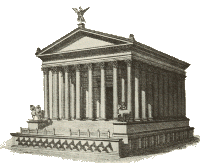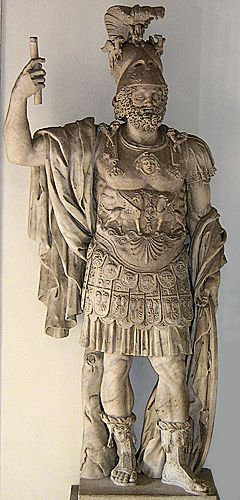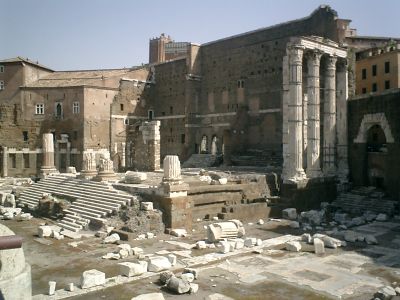Aedes Martis (Nova Roma)
Home | Latíné | Deutsch | Español | Français | Italiano | Magyar | Português | Română | Русский | English
⚜⚜⚜ Site Index - Key Pages ⚜⚜⚜
Aedes Martis
C. Decius Laterensis Flamen Martialis Novae Romae Est
pro populo Novo Romano
WORK IN PROGRESS
Mars
Mars, god of war, was originally an agricultural god whose character changed with that of His people. For this reason, He is the most Roman of the gods, representing the abundance of the fields, and the battles that must be won to keep and enlarge the provinces that kept Rome fed and thriving. He is the son of Iuno and Iuppiter, husband of Bellona, and the lover of Venus. He was the most prominent of the military gods that were worshipped by the Roman legions. The martial Romans considered Him second in importance only to Iuppiter. His festivals were held in March (named for him) and October.As the word Mars has no Indo-European derivation, it is most likely the Latinised form of the agricultural Etruscan god Maris. Initially Mars was a Roman god of fertility and vegetation and a protector of cattle, fields and boundaries and farmers. In the second century BC, the conservative Cato the Elder advised "For your cattle, for them to be healthy, make this sacrifice to Mars Silvanus you must make this sacrifice each year" (De Agri Cultura 83). Mars later became associated with battle as the growing Roman Empire began to expand, and he came to be identified with the Greek god Ares. Unlike his Greek counterpart, Mars was generally revered and rivaled Iuppiter as the most honoured god. He was also the tutelary god of the city of Rome. As He was regarded as the legendary father of Rome's founder, Romulus, it was believed that all Romans were descendants of Mars.
His priests were dancing warriors, the Salii, who sang their war-songs in the streets during his festivals. His sacred spears and 12 shields were kept in his temple on the Palatine Hill
Campus Martius
The Campus Martius (English: Field of Mars) in ancient Rome, was a floodplain of the Tiber River, the site of the altar of Mars and the temple of Apollo in the 5th century BC. Originally used primarily as a military exercise ground, it was later drained and, by the 1st century BC, became covered with large public buildings—baths, amphitheatre, theatres, gymnasium, crematorium, and many more temples. The Pantheon is the most notable structure extant. The historian Livy (1st century BC) called the area campus ignifer because of the volcanic smoke often seen there.


